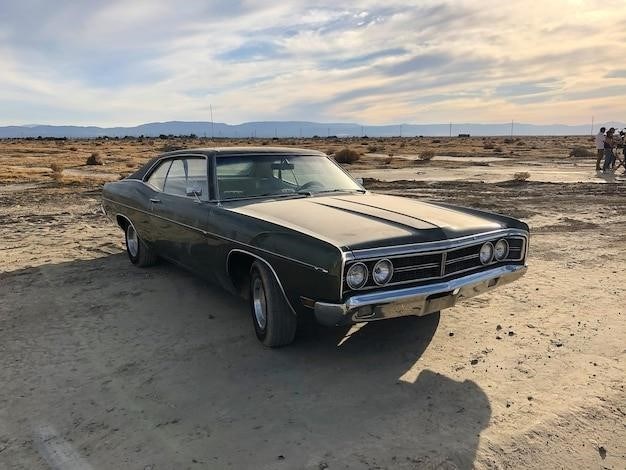Dodge Charger with Manual Transmission⁚ A History and Future Outlook
The Dodge Charger‚ a renowned muscle car‚ has a rich history intertwined with manual transmissions․ From its early days as a performance icon to its recent resurgence‚ the Charger’s manual transmission journey has been marked by both innovation and evolution․ This article explores the Charger’s manual transmission past‚ present‚ and future prospects‚ examining its legacy‚ its discontinuation‚ and the possibility of its return․
The Dodge Charger’s Manual Transmission Past
The Dodge Charger’s legacy is deeply rooted in manual transmissions‚ offering enthusiasts a direct connection to the car’s power and performance․ The early Chargers‚ particularly those from the 1960s and 1970s‚ were synonymous with manual gearboxes‚ providing drivers with a visceral driving experience․ The manual transmission was an integral part of the Charger’s identity‚ allowing drivers to fully exploit its engine’s capabilities and engage in a more active driving style․ The thrill of shifting gears‚ the precise control over engine speed‚ and the feeling of being in complete control were hallmarks of the Charger’s manual transmission era․
The availability of manual transmissions in the Charger during this period solidified its reputation as a driver’s car‚ appealing to those who sought a more engaging and rewarding driving experience․ The manual transmission became synonymous with the Charger’s performance heritage‚ contributing to its enduring appeal among car enthusiasts․ The Charger’s manual transmission past serves as a reminder of its roots and its enduring connection to the spirit of classic muscle cars․
The 1960s and 1970s⁚ A Manual Transmission Legacy
The 1960s and 1970s were a golden age for the Dodge Charger and its manual transmission․ These were the years when the Charger truly cemented its reputation as a performance icon‚ and the manual transmission played a pivotal role in this success; During this era‚ the Charger offered a range of powerful engines‚ from the iconic 440 cubic inch V8 to the potent 383 cubic inch V8‚ and all of them were available with a manual transmission․ These engines‚ paired with the manual gearbox‚ delivered an exhilarating driving experience that captured the hearts of car enthusiasts․
The Charger’s manual transmission options during this period included the three-speed manual‚ the four-speed manual‚ and even a four-speed manual with a Hurst shifter․ These transmissions provided drivers with a variety of gear ratios and shifting options‚ allowing them to tailor their driving experience to their preferences․ The manual transmission was an integral part of the Charger’s performance DNA‚ offering drivers a direct connection to the car’s power and agility․
The 1980s and 1990s⁚ The Rise of Automatic Transmissions
As the automotive landscape shifted in the 1980s and 1990s‚ the manual transmission’s dominance began to wane․ The introduction of more sophisticated and efficient automatic transmissions‚ coupled with a growing emphasis on fuel economy and ease of driving‚ led to a decline in the popularity of manual gearboxes․ This trend was particularly pronounced in the American market‚ where automatic transmissions became increasingly prevalent․
While the Dodge Charger still offered manual transmission options during this period‚ its availability gradually decreased․ The introduction of new engine options‚ such as the 5․2-liter Magnum V8‚ often came paired with automatic transmissions․ The Charger’s manual transmission legacy was fading‚ as the allure of automatic convenience and fuel-efficiency gained traction among consumers․
The 1999 Dodge Charger‚ for instance‚ while boasting a powerful 4․7-liter supercharged V8 engine‚ was only available with a five-speed manual transmission‚ demonstrating the declining popularity of the manual gearbox․
The 2000s and 2010s⁚ Manual Transmission Discontinuation
The shift towards automatic transmissions continued unabated in the 2000s and 2010s‚ eventually leading to the complete discontinuation of manual transmission options for the Dodge Charger․ This decision was driven by several factors‚ including evolving consumer preferences‚ the pursuit of enhanced fuel efficiency‚ and the advancements in automatic transmission technology․
As the Dodge Charger evolved into a more refined and technologically advanced vehicle‚ the demand for manual transmissions dwindled․ The focus on comfort‚ convenience‚ and fuel economy swayed consumers towards automatic transmissions‚ which offered smoother shifting and better fuel efficiency․ Moreover‚ the advent of multi-speed automatic transmissions‚ offering more gears for optimal performance and fuel savings‚ solidified the shift towards automatics․
The 2010 Dodge Charger SRT8‚ for instance‚ while offering a potent 6․4-liter Hemi V8 engine‚ did not offer a manual transmission option‚ reflecting the growing dominance of automatic transmissions in the market․
The 2020s⁚ The Return of the Manual Transmission in the Challenger
While the Dodge Charger bid farewell to manual transmissions in the 2010s‚ a surprising twist emerged in the 2020s with the return of the manual transmission in its sibling‚ the Dodge Challenger․ This unexpected move signaled a renewed appreciation for the visceral driving experience and the enthusiast community’s enduring passion for manual transmissions․
The 2023 Dodge Challenger Hellcat Redeye Widebody and the 2023 Dodge Challenger SRT Super Stock‚ both powered by potent Hemi V8 engines‚ were offered with a six-speed manual transmission‚ giving enthusiasts the option to engage in a more direct and engaging driving experience․ This revival of the manual transmission in the Challenger demonstrated Dodge’s understanding of the enduring appeal of manual transmissions among a dedicated segment of its customer base․
The Challenger’s manual transmission revival sparked renewed hope for the return of a manual transmission option in the Dodge Charger․ While the Charger’s future remains uncertain‚ the Challenger’s success with its manual transmission option suggests that Dodge is receptive to the demand for a more engaging driving experience․
The Dodge Charger’s Manual Transmission Present
The Dodge Charger’s manual transmission present is characterized by its absence․ The current generation of the Charger‚ launched in 2021‚ does not offer a manual transmission option․ This decision reflects the broader trend in the automotive industry‚ where automatic transmissions have become increasingly prevalent due to their convenience‚ efficiency‚ and advanced features․

Despite the lack of a manual transmission in the Charger‚ the model continues to offer a range of powerful engine options‚ including a 3․6-liter Pentastar V6‚ a 5․7-liter Hemi V8‚ and a 6․4-liter Hemi V8‚ all paired with an eight-speed automatic transmission․ These powertrains deliver impressive performance and efficiency‚ catering to a wide range of driving needs․
The absence of a manual transmission in the current Charger has sparked debate among enthusiasts‚ who miss the engaging driving experience offered by a manual gearbox․ However‚ Dodge’s decision to focus on automatic transmissions aligns with the industry’s shift towards more automated driving experiences․ Whether the Charger will ever see a return of the manual transmission remains uncertain‚ but the future of this beloved muscle car is still being written․
The 2024 Dodge Charger⁚ No Manual Transmission Option
The 2024 Dodge Charger‚ the latest iteration of the iconic muscle car‚ continues the trend of offering only automatic transmissions․ While the Charger has a long history with manual gearboxes‚ the current model prioritizes modern convenience and efficiency‚ opting for an eight-speed automatic transmission across its engine lineup․

This decision reflects the broader shift in the automotive industry towards automated driving experiences‚ with automatic transmissions becoming increasingly popular due to their seamless shifting‚ enhanced fuel economy‚ and advanced features․ While some enthusiasts lament the absence of a manual transmission option‚ Dodge’s focus on automatic transmissions aligns with the evolving demands of the modern driver․
Despite the lack of a manual transmission‚ the 2024 Charger still offers a compelling package of performance‚ technology‚ and style․ Its powerful engine options‚ coupled with the smooth operation of the automatic transmission‚ deliver a thrilling driving experience that caters to a wide range of preferences․ The future of the Charger’s manual transmission remains uncertain‚ but for now‚ the focus is on providing a modern and engaging driving experience with the latest in automotive technology․
Reasons for the Lack of a Manual Transmission
The absence of a manual transmission option in the 2024 Dodge Charger is a reflection of several factors‚ including market trends‚ production costs‚ and a shift towards automated driving experiences․ While manual transmissions were once a staple in performance cars like the Charger‚ their popularity has dwindled in recent years‚ with many drivers opting for the convenience and efficiency of automatic transmissions․
The production process for manual transmissions is generally more complex and labor-intensive than that for automatic transmissions‚ which contributes to higher manufacturing costs․ In an era of increasing production costs‚ automakers are seeking ways to streamline production and reduce expenses‚ making automatic transmissions a more cost-effective choice․ Furthermore‚ the development of advanced automatic transmissions with features like paddle shifters and adaptive programming has made them more appealing to performance-oriented drivers․
The Charger’s focus on modern technology and convenience also plays a role in its decision to prioritize automatic transmissions․ Features such as adaptive cruise control‚ lane departure warning‚ and automatic emergency braking are becoming increasingly common in modern vehicles‚ and these systems are typically integrated with automatic transmissions․ By offering only automatic transmissions‚ Dodge can ensure that its vehicles are equipped with the latest safety and convenience features․
The Dodge Charger’s Manual Transmission Future
The future of manual transmissions in the Dodge Charger remains uncertain‚ but it is not completely out of the question․ The recent return of the manual transmission in the Challenger Hellcat suggests that Dodge is aware of the enduring appeal of manual transmissions among certain enthusiasts․ However‚ the decision to equip the Charger with only automatic transmissions in 2024 indicates that the company is prioritizing other factors‚ such as cost-effectiveness and market trends․
The potential for a manual transmission in future Charger models will likely depend on several factors‚ including consumer demand‚ technological advancements‚ and market competition․ If a significant number of consumers express a desire for a manual transmission option‚ it is possible that Dodge would reconsider its current stance․ Additionally‚ advancements in manual transmission technology‚ such as the development of more efficient and user-friendly systems‚ could make them more attractive to both automakers and consumers․
Ultimately‚ the future of manual transmissions in the Dodge Charger will hinge on a delicate balance between nostalgia‚ practicality‚ and market forces․ While the current trend favors automatic transmissions‚ the enduring appeal of manual transmissions among certain enthusiasts suggests that they may not disappear entirely from the automotive landscape․
The Possibility of a Manual Transmission in Future Models
While the 2024 Dodge Charger does not offer a manual transmission option‚ the possibility of its return in future models remains a subject of speculation․ The recent reintroduction of a manual transmission in the Challenger Hellcat suggests that Dodge is receptive to the preferences of enthusiasts who value the driving experience offered by a manual gearbox․ However‚ the decision to omit a manual option in the Charger might indicate a shift in the company’s priorities‚ focusing on features that cater to a broader market segment․
The likelihood of a manual transmission reappearing in future Charger models hinges on several factors․ Consumer demand‚ technological advancements‚ and market competition will likely influence Dodge’s decision․ If a significant portion of potential buyers express a strong preference for a manual transmission‚ it could sway the automaker’s strategy․ Furthermore‚ advancements in manual transmission technology‚ resulting in more efficient and engaging driving experiences‚ could enhance their appeal․
Ultimately‚ the return of a manual transmission in future Dodge Charger models is a possibility that depends on a complex interplay of factors․ While the current trend leans towards automatic transmissions‚ the enduring appeal of manual transmissions among certain enthusiasts suggests that they may not be completely absent from the automotive landscape․
